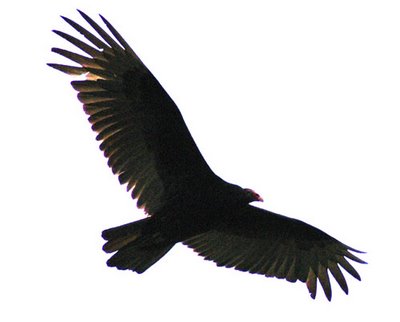
They’re back.
The sky over our back yard is full of turkey vultures.
They soar silently on huge black wings, seeking out rising warm air and flapping in to a landing in the tops of a line of tall trees that separate a broad expanse of lawn from an abandoned railroad right-of-way.
This is our sixth spring here, but we noticed them for the first time last year. It seems unlikely that we would have missed a roost of 50-or-so turkey vultures for four consecutive springs, so I can only conclude that they relocated to our neighborhood after something forced them to move.
I’ve long enjoyed watching them fly. I used to see them when my ex and I took our sons camping at Turkey Run State Park a few miles southwest of here back in the 1970s. That’s when I first looked them up in Roger Tory Petersen’s "Field Guide to the Birds of North America" and learned they are the second-largest birds in North America - eclipsed only by the nearly extinct California Condor, itself a form of vulture.
I admit I was mildly concerned about all those vultures peering down at my 4-month-old Australian shepherd puppy Pete.
So I went online to learn more.
Turns out, there’s no need to worry. Turkey vultures don’t kill anything. They won’t touch anything that isn’t dead. Besides that, they will pass on dead carnivores like dogs, cats and coyotes, preferring to dine on dead herbivores like sheep, goats and cattle.
The Cherokees called the turkey vulture the “peace eagle” because it soars like the predatory bird, but does not kill.
They are about 25 inches from end to end with a six-foot wingspan. The average adult turkey vulture weighs in at 6 pounds.
The turkey vultures around here are migratory, wintering in the U.S. south or perhaps as far south as Central America.
I remember seeing a humorous piece on the old Disneyland TV show back in the ‘50s about the festivities surrounding the return of the turkey vultures each spring to Hinkley, Ohio, much the same way the swallows come back to San Juan Capistrano on the same day each year.
I didn’t make note of the first sighting here this year, but I think it was around March 8. I’m marking my calendar to start looking for them in early March next year, just to see if and when they show up.
I also discovered turkey vultures even have their own fan club - The Turkey Vulture Society (vulturesociety.homestead.com).
Bill Kohlmoos, president of the Turkey Vulture Society, has written a fascinating piece about the birds in which he points out they have a rich social life, like to play aerial tag, and will invite other roosts to join them if they find a particularly large meal.
In California, he said, they’ve even been known to tell condors about major feasts and guide them to the scene.
Among his anecdotes:
“…it was reported by a person who had studied turkey vultures for many years that one would wait every morning for his son, a young school boy, to come out of his house. The vulture would follow the boy several blocks to the school bus stop and then wait on top of a telephone pole until the boy got on the bus. In the afternoon the bird would be back on the pole waiting for the boy's return, and then follow him home.”
And:
“One lady wrote us that she has built a small wooden tower-like feeder in her back yard and puts out food for her friends each day. One day she noticed that after eating their breakfast, the vultures had gone down to the lawn in her yard and six of them were in a circle around a soccer-size ball left on the lawn by her grandchildren. The vultures were hitting the ball back and forth to each other by butting it with their head and beak. Each day thereafter they played this game. And although there were four balls of different colors, they always picked the orange one.”
And:
“Turkey Vultures are affectionate and often make good pets. When a bird is injured and taken into rehab he will become emotionally attached to his handler and follow him around and watch him, much like a pet dog. They love to bring an object to a person and then play tug-of-war.”
And:
“A lady in Southern California wrote that she and her husband would drive their car five miles from town and take a daily walk in the country with their dog. A turkey vulture would join them, soaring above and watching them. And then one day at home she broke a leg and the walks were not possible for a while. One day she was in her back yard on crutches and there was her turkey vulture sitting on the fence, waiting to say hello. He had found her in a town of 12,000 people!”
Turkey vultures are covered by an international migratory bird treaty that makes it a federal crime to kill or injured them or to possess one without the appropriate permit as a wildlife rehabilitator.
No comments:
Post a Comment